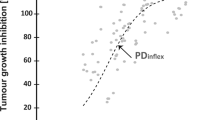Summary
SDX-308 and SDX-309 are potent indole-pyran analogues of SDX-101 (R-etodolac) which has anti-tumour activity unrelated to cyclooxygenase-2 inhibition. Their cytotoxic activity was further studied herein using a well-characterized human tumour cell-line panel containing ten cell lines, as well as in 58 primary tumour cell samples from a variety of diagnoses. The indole-pyran analogues of SDX-101 were in general considerably more active in both cancer cell lines and primary tumour samples. Low cross-reactivity with standard agents was observed, indicating a unique mechanism of action. No apparent influence on efficacy was observed via classical mechanisms of multidrug-resistance. SDX-101 and SDX-309 showed higher relative activity in haematological compared to solid tumour samples, while SDX-308 had pronounced solid-tumour activity. High SDX-308 cytotoxic efficacy was observed in non-small cell lung cancer, renal cancer and ovarian cancer samples, and also in chronic lymphocytic leukaemia. In conclusion, the indole-pyran analogues showed a favourable pharmacological profile and represent a potentially important new class of drugs for cancer treatment.





Similar content being viewed by others
References
Shiff SJ, Rigas B (1999) The role of cyclooxygenase inhibition in the antineoplastic effects of nonsteroidal antiinflammatory drugs (NSAIDs). J Exp Med 190:445–450
Patel MI, Subbaramaiah K, Du B et al (2005s) Celecoxib inhibits prostate cancer growth: evidence of a cyclooxygenase-2-independent mechanism. Clin Cancer Res 11:1999–2007
Johnson AJ, Smith LL, Zhu J et al (2005) A novel celecoxib derivative, OSU03012, induces cytotoxicity in primary CLL cells and transformed B-cell lymphoma cell line via a caspase- and Bcl-2-independent mechanism. Blood 105:2504–2509
Solomon SD, McMurray JJ, Pfeffer MA et al (2005) Cardiovascular risk associated with celecoxib in a clinical trial for colorectal adenoma prevention. N Engl J Med 352:1071–1080
Nardella FA, LeFevre JA (2002) Enhanced clearance of leukemic lymphocytes in B-cell chronic lymphocytic leukemia with etodolac. Blood 99:2625–2626
Adachi S, Leoni LM, Carson DA, Nakahata T (2004) Apoptosis induced by molecular targeting therapy in hematological malignancies. Acta Haematol 111:107–123
Lindhagen E, Nissle S, Leoni L et al (2006) R-etodolac (SDX-101) and the related indole-pyran analogues SDX-308 and SDX-309 show potentiating cytotoxicity with standard cytotoxic agents in primary patient chronic lymphocytic leukaemia cells. Cancer Chemother Pharmacol (in press)
Lu D, Zhao Y, Tawatao R et al (2004) Activation of the Wnt signaling pathway in chronic lymphocytic leukemia. Proc Natl Acad Sci USA 101:3118–3123
Bendall H, Bailey B, Reifert J et al (2004) SDX-101, a novel chemotherapeutic agent in clinical development, inhibits beta-catenin. Proceedings of the AACR 45
Kolluri SK, Corr M, James SY et al (2005) The R-enantiomer of the nonsteroidal antiinflammatory drug etodolac binds retinoid X receptor and induces tumor-selective apoptosis. Proc Natl Acad Sci USA 102:2525–2530
Fridborg H, Jonsson E, Nygren P, Larsson R (1999) Relationship between diagnosis-specific activity of cytotoxic drugs in fresh human tumour cells ex vivo and in the clinic. Eur J Cancer 35:424–432
Larsson R, Kristensen J, Sandberg C, Nygren P (1992) Laboratory determination of chemotherapeutic drug resistance in tumor cells from patients with leukemia, using a fluorometric microculture cytotoxicity assay (FMCA). Int J Cancer 50:177–185
Csoka K, Larsson R, Tholander B et al (1994) Cytotoxic drug sensitivity testing of tumor cells from patients with ovarian carcinoma using the fluorometric microculture cytotoxicity assay (FMCA). Gynecol Oncol 54:163–170
Dhar S, Nygren P, Csoka K et al (1996) Anti-cancer drug characterisation using a human cell line panel representing defined types of drug resistance. Br J Cancer 74:888–896
Yasui H, Hideshima T, Hamasaki M et al (2005) SDX-101, the R-enantiomer of etodolac, induces cytotoxicity, overcomes drug resistance, and enhances the activity of dexamethasone in multiple myeloma. Blood 106:706–712
Acknowledgements
The invaluable help of Sara Nissle, Lena Lenhammar, Christina Leek and Caroline Haglund is gratefully acknowledged.
Conflict of Interest
None declared.
Author information
Authors and Affiliations
Corresponding author
Additional information
Salmedix Inc., San Diego, CA, USA is a subsidiary of Cephalon, Inc., Frazer, PA, USA.
Rights and permissions
About this article
Cite this article
Lindhagen, E., Rickardson, L., Elliott, G. et al. Pharmacological profiling of novel non-COX-inhibiting indole-pyran analogues of etodolac reveals high solid tumour activity of SDX-308 in vitro. Invest New Drugs 25, 297–303 (2007). https://doi.org/10.1007/s10637-007-9049-4
Received:
Accepted:
Published:
Issue Date:
DOI: https://doi.org/10.1007/s10637-007-9049-4




